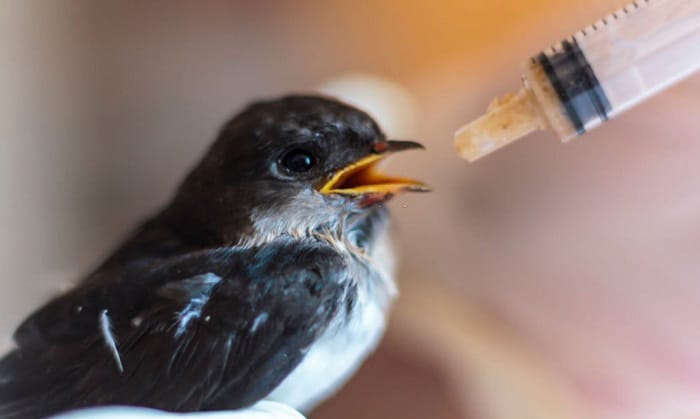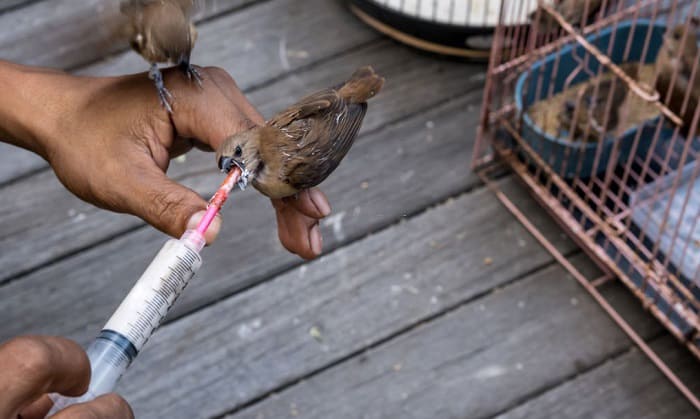Bird lovers like yourself simply cannot ignore a scared little bird on the ground. You’ll surely be sympathetic if you encounter an injured chick, but you need to know the law first. Take note that it’s illegal to bring a bird home, regardless of its age. So unless you have a permit, refrain from doing so.
The best way on how to save a baby bird from dying is to contact a local animal rehabilitator. You need a professional to take care of the wounded young avian. However, there are helpful things you can do to save the baby chick.
Table of Contents
- Step by Step Guide on How to Save Young Birds From Harm
- What Are Needed To Save Chicks From Dying
- Detailed Steps on a Baby Bird Rescue Mission
- Step #1: Investigate the scene
- Step #2: Determine the age of the baby bird
- Step #3: Safety first
- Step #4: Find the nest
- Step #5: Build a makeshift nest
- Step #6: Find a safe spot for the surrogate nest
- Step #7: Provide food and water
- Step #8: Monitor the nest and its occupant
- Step #9: Contact a licensed animal rehabilitator
- Conclusion
Step by Step Guide on How to Save Young Birds From Harm
What Are Needed To Save Chicks From Dying
Saving a young passerine is a good move. And in following your heart, you need certain materials required to keep the injured baby bird from dying.
- Nest box (cardboard, basket, plastic container)
- Soft clean cloth
- Tissue paper
- Towel
- Earthworms or other insects
- Birdseed
- Water
- Gloves
- Heating pad
- Alcohol
- Dropper
Detailed Steps on a Baby Bird Rescue Mission
To rescue a baby bird, you need to check the status of the baby bird and be sure that you can perform this task excellently. There must be no doubt in your mind, because a creature’s life is at stake.
Let’s discover the efficient steps in how you can achieve your goal.
Step #1: Investigate the scene
If you see a young chick on the ground, you should investigate the scene. Check if the baby bird fell out of nest, or if it seemed abandoned. Look for obvious signs of injuries, and check for nests nearby.
Try to remember if there had been a bad weather condition that could have knocked the baby bird from the nest. If not, then probably the young chick tried to fly but failed.
It is also important to find out if the parents are around. At this point, if the wounded chick is alone, you should call a licensed rehabilitator. Or, if you know that you can handle a simple rescue process, follow the next step.
Step #2: Determine the age of the baby bird
Once you’ve decided to save baby birds from further harm, you need to figure out if you’ve found a nestling or a fledgling. Knowing the difference between the two kinds of baby birds can help you in your rescue pursuit.
- Nestling – a newborn bird that has no ability to fly yet. It is naked as well, with very few feathers. If this baby passerine is on the ground, the best guess is it fell from its nest.
- Fledgling – this kind of baby bird is ready to take on the world with its full plumage. It has left its nest, but this young avian fell from the air for some reason.
Knowing the age of the injured helps you determine what to do. If you found a nestling, there’s a high chance that the nest is near you. And if it’s a fledgling, then the possibility is the nest is not in the area.
Step #3: Safety first
Even if you have a desperate need to keep a baby bird alive, you must think of your safety. Chicks can carry diseases that may make you sick. And so, before you do anything, get yourself a pair of gloves.
Once you have the gloves on, pick up the injured young passerine. You can either carry it or place it in a safe spot away from predators, kids, and pets. And then proceed to the next step.
Step #4: Find the nest
Whether you find a nestling or a fledgling, the next move is to find the nest. Take note that newborn birds cannot live outside the nest yet. So finding their home is crucial to save a bird from dying.
The good news is, the nestling is nearby since they cannot fly yet. And if the nest is intact, simply return the chick to its nest. The parents will take good care of the wounded newly born bird.
As for the fledgling, it’s a bit more challenging to locate the nest. The young bird could have flown far away, so you may not find its home. And if you do, place the baby bird back and trust the parents to care for their young.
However, if the nest is nowhere to be found, then be creative.
Step #5: Build a makeshift nest
To save a nestling from dying or a fledgling from more harm, use your imagination and build a surrogate nest. Find a cardboard box, plastic container, basket, and other materials that can be used as a nest box.
Make sure that the walls of the temporary box are shorter than the baby bird. And drill holes on every corner and bottom in order to keep the young chick well ventilated.
It’s important to provide comfort for the injured bird by putting tissue paper on all sides and the base. To keep a baby bird warm, place a heating pad and top it with a soft clean cloth.
In building an interim nest, do not use slippery materials or cloths with large holes. These items are risky to the baby passerine since it could slip or the legs could get caught in the holes.
Step #6: Find a safe spot for the surrogate nest
Once the stand-in nest is ready, place the baby bird inside, and cover it with a clean and lightweight towel.
Then find a safe place to put the nest, preferably in a flat tree branch. You can also find other spots like in your backyard.
No matter where you intend to place the improvised nest, just make sure it’s secure. There must be no predators nearby, no noisy children, and no pets that can reach the resting passerine.
The most important aspect of this step is to ensure that the parents of the young chick can find their baby. So it’s ideal to place the makeshift nest close to where you found the nestling or fledgling.
Step #7: Provide food and water
It is usually the responsibility of the parent birds to feed their young. Still, since they’re not around, the duty falls on you. To revive a baby bird from weakness, feed a nestling with an earthworm or other insects and bird seeds to the fledgling.
Also, place an open water container for the fledgling to stay hydrated. As for the nestling, they cannot drink on their own so use a dropper to feed the newborn passerine with water.
Keep in mind that you must not leave a bunch of food inside the nest. Doing so will allow the young bird to eat them all, which will cause it harm. The thing to do is personally the baby avian with a small amount of food.
Step #8: Monitor the nest and its occupant
When the rescued chick is safe inside the surrogate nest, monitor it and the occupant. Let a few hours pass and wait for the parents to find their young. Watch over the injured young avian to make sure that no harm will come to them.
If there are predators nearby, shoo them away. Keep the kids at a distance so the parent passerines will not get spooked from rescuing their baby.
Monitoring the baby avian could take hours, or even days. The most important thing is, you watch over your rescued little creature until it has recovered or is strong enough to fly.
Step #9: Contact a licensed animal rehabilitator
Your best efforts may be enough to save the nestling or the fledgling, but you’re still not a professional rescuer. It’s ideal to contact a local licensed animal rehabilitator and report what’s going on.
Newborn baby birds are vulnerable in many ways, especially the wounded ones. So even if you have done everything you could to save the young passerine, you cannot watch over them for a long time.
Use the internet to search for the number of the local wildlife rehabilitator. Tell them the condition of the injured bird when you found it and what you have done so far.
Then leave the baby bird in the nest after the call. Or you have the option to wait for the professional rehabilitator and then go on your way.
Conclusion
The steps on how to save a baby bird from dying are quite simple yet complex. But by following the steps, you can safely rescue a wounded nestling or fledgling. By creating a surrogate nest and feeding the young passerine, you’re saving the little creature.
However, never forget that the injured young bird is better off with a licensed animal rehabilitator. So when you find a helpless baby bird, contact a local professional. In case you can’t get in touch with them, check out this article to know what you need to do first.
We hope you learned a lot from this guide on saving a young avian. Kindly share this post, and let us know what you think.

George and I became friends after a birdwatching trip with our new group. And we have been enjoying every adventure together. When he told me the idea of establishing a site that shares our experiences and fun, I immediately agreed. After trials and errors, here we have Thayerbirding.
















